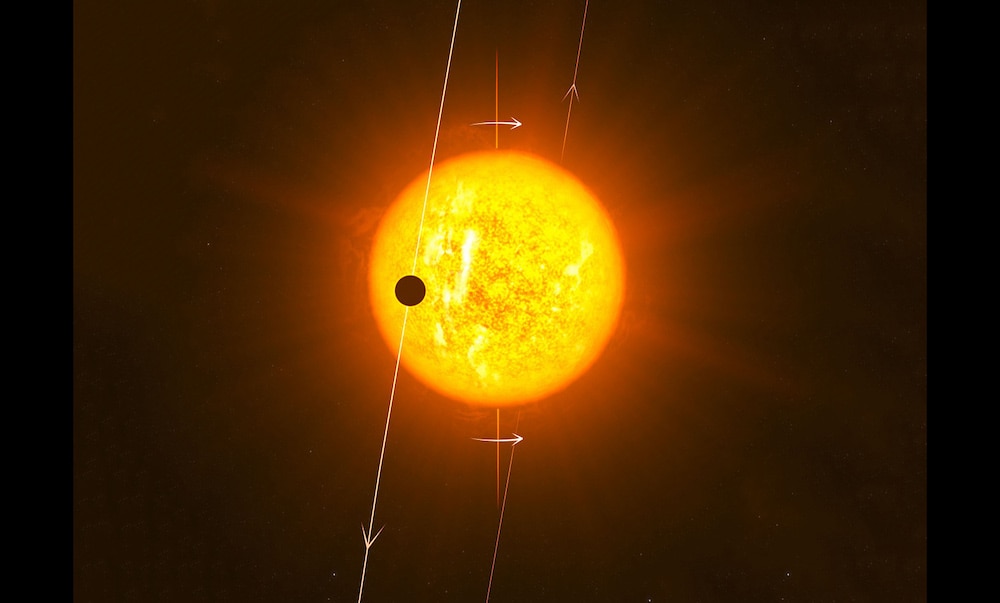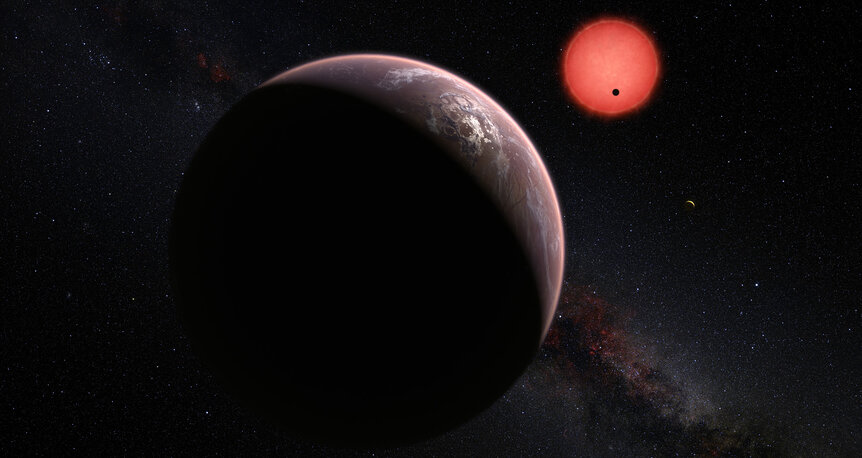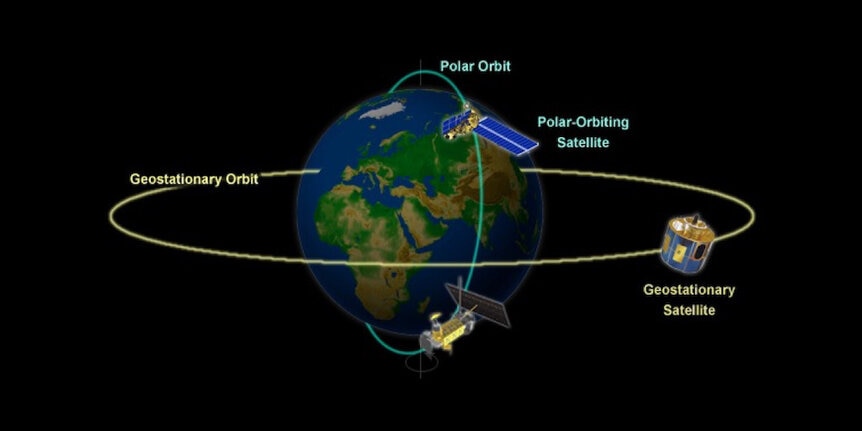Create a free profile to get unlimited access to exclusive videos, sweepstakes, and more!
Puzzling planets perpetrating perpendicular paths perplex people
Nearby star HD 3167 has planets orbiting at right angles

One of the most obvious things about our solar system is that all the big planets orbit the Sun in very nearly the same plane. If you looked at the solar system “from the side” it would look very nearly flat.
This is a consequence of how our planets formed. Billions of years ago, a cloud of gas and dust started to collapse. Any rotation in that material would get amplified as it shrank (think of an ice skater spinning more rapidly when they bring their arms in), and (due to centrifugal force) any stuff in the plane of that rotation has a harder time falling to the center than stuff near the poles. You wind up with a huge disk of gas and dust billions of kilometers across, with the forming Sun in the center and the planets all orbiting in the plane of the disk. Not only that, because of all this the star rotates in the same direction the planets go around, and the orbits of the planets align with the star's equator (we say they’re coplanar).
That’s true for other solar systems as well. We see these disks everywhere stars and planetary systems are forming, and it’s a decent bet that planets will all align to that disk.
… but it’s not always the case. And it’s really super not the case for the nearby star HD 3167. We know of three planets orbiting it, and two of them actually orbit perpendicular to the other one!
HD 3167 is a K star, just a slightly bit smaller, cooler, and dimmer than the Sun, located about 150 light years from us. In 2016 two planets were announced orbiting the star, found using that transit method.
The inner one, called HD 3167b, is a super-Earth, about 1.7 times the diameter of our homeworld and five times its mass. It’s on an orbit very close to the star, taking just 0.96 days to go around once. It’s surface temperature is likely around 1500°C (2,700°F) so Earth-like it very much ain’t.
The outer one, called HD 3167c, is a mini-Neptune, about 3 times wider than Earth and 10 times its mass. It takes about a month to orbit the star once, and while it’s farther out it’s still close enough to the star to have a temperature hot enough to boil water.
Not long after, it became clear there must be a third planet in the system (discovered by my friend Jessie Christiansen!). It doesn’t transit the star, but planets have gravity, and as they orbit the star they tug on it. This makes the star do a little reflex circle as the planets swings around in its orbit, and while the orbit is too small to see directly, the velocity of the star as it moves around is measurable as a Doppler shift. This planet is called HD 3167d and it orbits in between the other two, circling the star once every 8.5 days (note that the planets are named in order of discovery, not distance from the star, so the order here out from the star is b, d, c).
The discovery paper shows that the orbit of planet d is weird, and it didn’t take long to show this whole system is weird: While planet b orbits around the star over its equator and in the same direction the star spins, planet c is very nearly in a polar orbit, perpendicular to it. Not only that, but so is planet d!
That’s truly bizarre. To understand this better, a new paper has come out analyzing the system very carefully. They use a refined technique to confirm that planets c and d are in polar orbits, with tilts pretty close to one another (the angle between the two orbits is between 2 and 21°).
How did they do this? Using a technique called the Rossiter-McLaughlin effect.
Imagine you’re looking at a star over its equator, so the north pole of the star is at the top and the south pole at the bottom. It’s spinning left to right. That means the left side of the star is rotating toward you, and the right side rotating away from you. This induces a Doppler effect in the star’s light; light coming from the left side has a very slightly shorter wavelength (we call this blueshift) and the right hand side has a very slightly longer wavelength (redshift). A spectrograph can break the star’s light up into thousands of individual wavelengths (colors), and what it sees in a case like this is the wavelengths are slightly smeared out, since it sees the whole star’s motion all at once.
Now say a planet transits the star, and it orbits in the same direction as the star spins (left to right). It first blocks a little bit of the star on the left, then moves to the star’s center, then blocks the light to the right. If you take spectra during the transit, you’ll see some of the blueshifted light from the star dim first, and the redshifted light dim later. That tells you the planet orbits the star prograde, in the same direction it spins.
In some cases we see the opposite: The redshifted light dims first, then the blueshifted light. That means the planet orbits retrograde, backwards.
If the planet is orbiting tilted with respect to the star’s equator you get a variation on this, with slightly different blueshifted and redshifted light dimming at different times. It’s incredibly difficult and exacting work, but it’s possible to get the orbital tilts of the planets this way.
And that’s what they did in the new paper. Planet b orbits prograde like a good little planet, but the other two orbit perpendicular to it, over the star’s poles: a polar orbit.
That’s so weird! How can this happen?
They think that all three planets formed normally, like ours did, and all started out life orbiting in the same plane. But they posit a fifth object in the system orbits farther out, which could be a very low-mass star or a fourth planet. The details are complex, but objects on elliptical and slightly tilted orbits can change the shape and tilt of other objects in the system. Over time, this other object gravitationally interacted with planets c and d, flipping them up into these polar orbits. Planet b was too close to the star to be affected.
This may happen in other systems, too, where we see retrograde or polar planets. WASP-79b is an example of this, and it can happen in binary star systems as well.
The trick now is to find that other object. That may be impossible with current tech; it may not transit and it may also be too faint and too far out to detect otherwise. At least for now. Astronomers are clever folks and keep getting better at figuring out how to do things like this.
And oh how I love this news! Our solar system is amazing and wondrous and fascinating, and yet compared to some others it’s pretty vanilla. Nature has a way of bollixing things up, of throwing a curveball into what we might consider “normal.”
But normal is just an average, a spot on a graph you pick because lots of things hang out around it. But lots of things don’t, and the more we learn about them the more we can understand what normal really means.





























